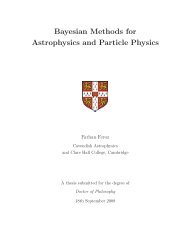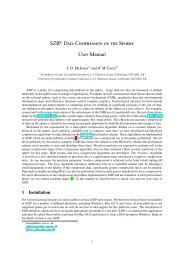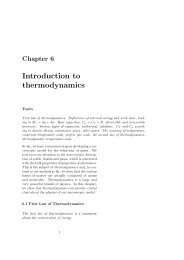Self study guide: Fortran 95 - University of Cambridge
Self study guide: Fortran 95 - University of Cambridge
Self study guide: Fortran 95 - University of Cambridge
Create successful ePaper yourself
Turn your PDF publications into a flip-book with our unique Google optimized e-Paper software.
1. The Basics<br />
In this section we will look at the basics <strong>of</strong> what a program is and how to make the<br />
program run or execute.<br />
The non-trivial example programs can be found in the directory:<br />
$PHYTEACH/part_2/examples<br />
with the name <strong>of</strong> the file the same as that <strong>of</strong> the program discussed in this <strong>guide</strong>.<br />
Some sections are more advanced and are indicated clearly indicated by a thick black<br />
line to the right <strong>of</strong> the text. These can be skipped certainly on a first reading and<br />
indeed you will be able to tackle the problems without using the material they discuss.<br />
1.1 A very simple program<br />
A program is a set <strong>of</strong> instructions to the computer to perform a series <strong>of</strong> operations.<br />
Those operations will <strong>of</strong>ten be mathematical calculations, decisions based on<br />
equalities and inequalities, or special instructions to say write output to the screen.<br />
The program consists <strong>of</strong> “source code” which is “stored” in a text file. This code<br />
contains the instructions in a highly structured form. Each computer language has a<br />
different set <strong>of</strong> rules (or syntax) for specifying these operations. Here we will only<br />
consider the <strong>Fortran</strong> 90/<strong>95</strong> (F<strong>95</strong> for short) programming language and syntax.<br />
• Using emacs enter the following text into a file called ex1.f90, the .f90 part<br />
<strong>of</strong> the file name is the extension indicating that this is program source code written<br />
in the <strong>Fortran</strong> 90/<strong>95</strong> language<br />
program ex1<br />
!<br />
! My first program<br />
!<br />
write(*,*) ’Hello there’<br />
end program ex1<br />
This is a complete F<strong>95</strong> program.<br />
The first and last lines introduce the start <strong>of</strong> the program and show where it ends.<br />
Between the first and last lines are the program “statements”. The lines beginning<br />
with an exclamation mark are special statements called comments. They are not<br />
instructions to the computer, but instead are there to enable us (the programmer) to<br />
improve the readability <strong>of</strong> the program and help explain what the program is doing.<br />
The line beginning write is a statement giving a specific instruction to print to the<br />
screen.<br />
3






